![]() Click here to read about Shanghai AKA The Turtle
Click here to read about Shanghai AKA The Turtle
![]() Click here to read about Four Rivers AKA Shisensho
Click here to read about Four Rivers AKA Shisensho
![]() Click here to read about Catching The Tortoise
Click here to read about Catching The Tortoise
![]() Click here to read about Paihinmin
Click here to read about Paihinmin
![]() Click here to read about Mahjong Bingo
Click here to read about Mahjong Bingo
Here is how to play the most traditional tile-matching game first popularized by Activision's "Shanghai" and also by other computer games like "Taipei" and "Kyodai" and often erroneously called "mah-jongg." Perhaps it is best called "mah-jongg solitaire." Some folks in China call it...
"THE TURTLE"
So we'll call it "The Turtle," or "Shanghai," interchangeably.
-
0. If you have not done this before, there is a first step that you only need to perform one time. Mah-Jongg sets come in many varieties and configurations. Almost all sets include Flowers and Seasons (which may not necessarily resemble flowers or seasons). You need to identify these tiles and familiarize yourself with them.
- Remember that there are four of each tile (see FAQ 7b to familiarize yourself with all the tiles in the mah-jongg set). When removing a pair, remember that an identical pair exists in the layout. Is it trapped by your removal of the first pair? Choose wisely.
- If all four of a tile are available, remove them all to unclutter the field.
- Concentrate your efforts on long rows and tall stacks.
- Plan ahead as many moves as you can.
- Identify as many visible matching pairs as you can. Check for tiles that need to be unblocked.
- Concentrate on removing pairs that will unblock the most tiles.
- Beware of triples (three matching free tiles); choose carefully which pair you remove. Leave the one that's blocking the least important tiles.
- When playing on the computer, don't count on the computer to show you the best possible move; the computer only shows the first move it finds, or all the moves it finds... (Assuming your tile-matching game has a Hint feature; not all do.)
Take all the tiles out of your set and divide them up by type (organizing the suit tiles numerically), as shown in FAQ 7a.
Especially you need to study the flower/season tiles. Flowers and Seasons are non-identical matching tiles. All the flower tiles match one another; all the season tiles match one another; flowers do not match seasons. If you can't tell the flowers from the seasons, just leave some of them out, or substitute other special tiles that may or may not be included with your set. Just set a table rule that says "these 4 tiles match one another."
1. Stack the tiles randomly into a pyramid shape or a turtle shape (actually, any shape structure you like is fine). It is usual to stack all the tiles face up.

This is the typical layout used by most computer "mah-jongg solitaire" games.
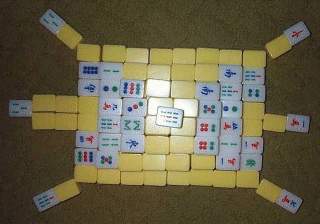
This layout was described and shown to me by a Chinese friend who learned it from family members. Note how (1) blocked tiles are turned face-down (you turn them face-up only when they become unblocked), and (2)the tiles are oriented horizontally. If you want to use this "tortoise" layout ...

... then I recommend this vertical orientation of the tiles. Reason: it's easier to slide a tile out when there is less surface contact along the shorter edges.
2. There are four of each tile, which can be removed as two matching pairs. The object is to remove all the tiles from the layout, one pair at a time. To remove a pair, the tiles must both match and be "free" at the same time. A tile is considered free if no other tile is on top of it and if it can slide out to the left, to the right, or in both directions. If a tile can only slide toward the top or the bottom of the layout, it is not free to be removed. It's that simple. But wait - because there are four of each tile, you may well find yourself stuck, with unmatchable tiles blocking other key tiles so you can't clear the layout. As you continue to play game after game, you will form your own winning strategies. Because you are not playing on the computer, you can't undo previous matches and try to fix any mistakes, shuffle the remaining tiles, or put them all back to the way they were at the beginning so you can try again. And there's nobody to tell you when you're stuck. Computer tile-matching games give you abilities not available with real Mah-Jongg tiles.
3. If you get stuck, mix the tiles all up and repeat from step 1.
4. If you win, follow the direction in step 3 above.
STRATEGY
Here is the COMPLETE strategy guide to Shanghai-type tile-matching (taken from the Shanghai Second Dynasty Help menu):
TWO-PLAYER
Although this game is often referred to as "solitaire," you can easily play it with 2 or more people. There are several ways you can do this:
A. Cooperative. No special rules -- just work the puzzle together.
B. Competitive. Several ways to go here:
i. Speed free-for-all. The two of you attack the layout together, removing pairs. When you remove a pair, put it on your side of the table. At the end (when the layout is clear or unwinnable) the player with the biggest pile of tiles wins.
ii. Taking turns. Each player gets a turn at removing a pair. A player's turn ends when the player removes a pair or the player concedes (cannot see a pair to remove). Game ends when the layout is cleared or unwinnable by mutual agreement. Player with biggest tile pile wins.
iii. Time-limited turns. Get a one-minute timer. Start it at the beginning of each player's turn. Inevitably, some turns will result in a match being removed and some won't. At the end (when the layout is clear or unwinnable) the player with the biggest pile of tiles wins.
You can also play this solitaire game with all the tiles face-down, but in my opinion that's overkill (it's already hard enough without a computer to help you). Click here to jump to Tom's Three Rules on Table Rules.
SHISENSHO
-
This game is also sometimes called "Szechuan" or "Four Rivers" - Szechuan being the Chinese name for an area in China, Shisensho being the Japanese name of the same area, and Four Rivers being an English translation of that name. You can find computer versions under other titles also: The Curse of Ra (Rah-Jongg), Nikakudori, Winojong, RongRong... I have spent a lot of time in Japan, so I tend to use the Japanese name.
Solitaire games played with mah-jongg tiles are often better on the computer than they are with real tiles. This is one of those. The computer performs actions that can't be done in real life, and the computer can also tell you when you're stuck, can automatically time you and score your performance. The computer can also arrange the tiles in a "guaranteed winnable" fashion. If you are building the layout yourself, you are likely to place the tiles randomly. So there's a reason why some of these games are played mainly on the computer more than on actual tables, with actual tiles.
Here's how Shisensho is played.
1. First, you arrange tiles randomly, usually in a rectangular grid (but other patterns are also perfectly fine - see FAQ 14). Don't use all 144 tiles. Just use one suit, or one suit and the winds. Or one suit, the dragons, and the winds and flowers. Whatever number you like. But make sure that you always use all 4 of any tile that you include in the layout, else the game will not be winnable!
2. Now you're ready to play. The goal is to remove all the tiles (just as in The Turtle AKA Shanghai). As in Shanghai, you remove them by matching identical tiles. But (here's the tricky part), the rule is that tiles can only be removed if they can be connected by an imaginary line - an imaginary line with no more than two right-angle bends in it. I know, it sounds weird and contrived, but that's the rule. Once you get used to it, you'll enjoy the game just fine. The line cannot pass through any tiles (the line must pass through empty space only).
Let's see some examples that illustrate this point.
Here (below) is a rectangular layout using 96 tiles (12 columns, 8 rows). See if you can spot the matching tiles that can be matched, according to the rule outlined above. Try to do it without peeking at the solution, below.
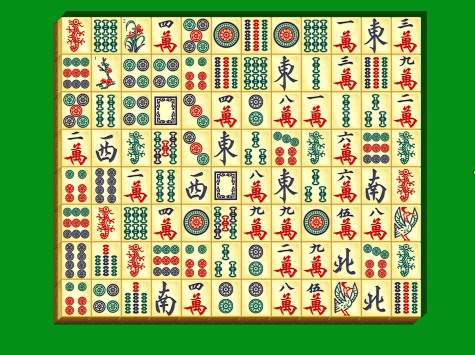
Ready? Scroll down and have a look, then.
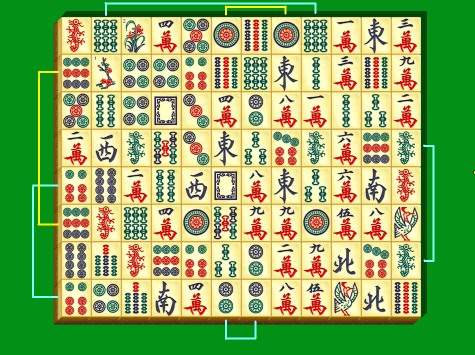
Whoa! That's a lot of possibilities there. On the left, you can match the 6 Dots and the 9 Dots. Along the top, you can match the 6 Bams and the 1 Dots. On the right, you can match the Green Dragons, and along the bottom, you can match the 2 Dots. See the two 1 Bams (the bird) at the bottom right corner area? Those cannot be matched. It would require a line with three right-angle bends, and that would be in violation of the rules.
As you clear away tiles at the edges, other tiles become available for matching. Take a look at the next example, and see if you can find the available moves.

Ready? Scroll down and see.

Now there are two moves available - the 6 Dots and the 7 Bams. After clearing those away, there will be a move with 3 Dots. Then 8 Dots, then 4 Bams, then 2 Bams...
Like I said above, sometimes you will be starting with non-rectangular layouts:

Ready to see the moves for this one? Scroll down.
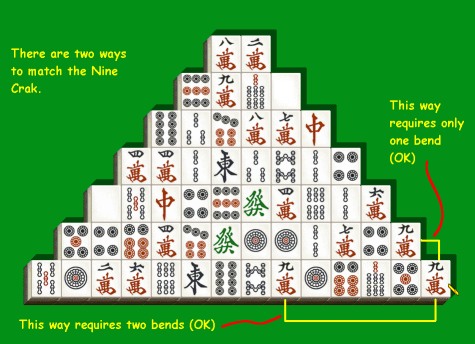
Choose wisely, Grasshopper! Whichever choice you take will determine what further moves you will be able to take. This lesson is now over. Enjoy playing, Grasshopper.
CATCHING THE TORTOISE
- It's unfortunate that the Chinese call "Shanghai" (for lack of a better English name) and this game by such similar-sounding titles. But what can you do.
Here's a very quick little solitaire game you can play.
Take all the tiles of one suit (any one suit). Shuffle them face-down. Line them up in a block, nine tiles wide by four tiles high.

Take any tile from the top row and look to see what number it is.

It's the number three, so count three tiles from the left, and place the tile above the third column of tiles.
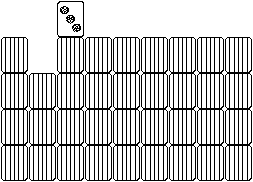
Now push it towards you, forcing a tile out the bottom of the column.

Take that extra tile, observe its number, and put it in its proper column.

It's a seven, so we put it on the seventh column.

Keep doing this until you have either created an organized face-up block of tiles or you are unable to do so. (You can get stuck if you complete the first column, the one you first opened, before finishing the rest of the block.)
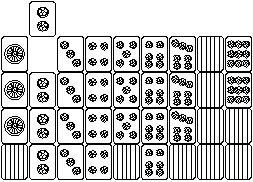
Above - I'm stuck. The last tile I pushed out the bottom was a two, completing the second column. So I don't have any more moves.
When this doesn't happen, you should wind up with a fully complete arrangement as shown below.

As many as three people can play this game simultaneously (since there are three suits in a set). Each player gets the tiles of one suit. It's a race to see who can finish, or who can finish first. If playing this with your mah-jongg group while one player is off fixing food or taking a phone call or something, you can apply points commensurate with the system you use for regular mah-jongg.
[Cinco de Mayo, 2003] Tip from reader Benjamin, who suggests a way that four can play at a time. While three players get the 36 tiles of one suit each, the fourth player can get the 36 tiles made from the winds, dragons, flowers, and seasons. Benjamin says, "What we do is just expose the tiles as in regular play, but then each wind or dragon is placed in the next available column, until all columns have been identified." The tricky part, I presume, is how to handle the flowers and seasons. In most sets, these are distinguishable only by the differing colors of the numbers. For example, the flowers might be numbered in blue, while the seasons are numbered in red. Or the flowers' numbers might be in the left corner, while the seasons' numbers are in the right. Some sets have four animal tiles and four flower tiles - or these tiles might be labeled with abbreviations for season and flower names. Or maybe your set has four blanks, or four jokers you can use. Depending on your tiles, you should be able to find a way to distinguish one set (seasons) from the other (flowers).

In this example, the first tile I got (from the 7th column) was White. I put it into the 1st column. That pushed out a blue flower (clearly marked as a Season, with the number in the right corner), which went into the 2nd column. After pulling an East, which went into the 5th column, the next tile was a red flower (marked with flower names - "bamboo" being one of the traditional flowers - and with the number in the left corner). See? It's easy, and fun! Benjamin is a teacher, and he says, "The kids like it. This game was also a huge success at our recent math and science family night. Parents were as enthusiastic as their children."
PAIHINMIN
- Here's a very interesting game I learned in Japan, called paihinmin, a trumping game played with mah-jongg tiles. Paihinmin can be translated as "poor people ranking." It's based on a hierarchy of the tiles in the mah-jongg set as follows. Two to four players.
The strongest tile in the set is the Nine Crak, followed by the Nine Dot, then the Nine Bamboo, and so on.

After the Ones, the hierarchy goes down through the winds (E, S, W, N) then the dragons (W, G, R). So the weakest tile in the set is the Red Dragon. Flowers and jokers are not used (this game is designed for the Japanese tile set of 136 tiles.)
Gameplay is fairly simple. I don't have time to go into a lot of examples at the moment. Just try playing it, develop your own table rules. (Click here to see The Rules on Table Rules.)
Build four mah-jongg walls of 17 stacks each. Each player takes one entire wall. Line them up as best you can, standing on end (they won't all fit on American-style racks), in order of strength, suit, etc. With the dice, determine who will go first (high roll). That player must make some sort of tile combination, face-up on the table. A single tile, a pair, a pung, kong, or chow. In turn, each player then must outscore the exposure made by the first player. Your set must be in the same form as the play made by the preceding player (for example, if he plays a pair, you cannot play a chow or pung, you also must play a pair, only yours must "rank" higher). If the preceding player makes a 4-5-6 chow in Bams, the next player could make a 4-5-6 chow in Dots or Craks -- or could make a 5-6-7 chow. (As I said above, I leave it to you to determine further details -- try it, you'll figure out what works.)
When a player wins a trump, all exposed tiles are moved aside, and that player (the one who won the trump play) makes an exposure.
When a player cannot trump a play, he passes. If all four players pass, the last player who made an exposure makes another exposure.
The winner is the player who uses up all his tiles while other players still have tiles in the hand. That's pretty much all there is to it! You can add other rules to it if you like (see FAQ 14).
MAHJONG BINGO
- This one I learned from Masa Yaehata at a "Free Play" gathering of the Pacific Mahjong League, SoCal branch (see column 649). Mahjong Bingo can be played by up to 4 people. I don't recall every detail of what Masa taught us, but hey, I'm a game designer. And it's not like there is just one "correct" and "true" set of Mahjong Bingo rules. You, too, can modify the rules if you like (see FAQ 14).
Shuffle the tiles, build walls, and deal 25 tiles to each player. Each player displays his tiles face-up in a 5x5 array. Then in turn, each player picks from the wall and looks to find a match between the picked tile and the 5x5 array. If a match is found, the tile is turned face down. First player to make a 5-tile row of tile backs wins.

Sounds simple enough, but questions are bound to come up. I say you can guess what the answers ought to be, and you can also try various answers to find out what works best. For example, a question you might ask when playing the game is "what if my picked tile matches two tiles in my array?" I can think of two reasonable answers:
1. Only one of your two can be flipped over - and you get to use stragedy to decide which to flip.
2. You're allowed to flip them both.
I don't remember what Masa may have said on this issue, but it doesn't matter. Just try one rule, then on a subsequent game, try the other. See which is more fun (#2 is surely more exciting).
Another question might be, "should players play sequentially, one player at a time, or can all players make a move at the same time?" I think new players would want to play sequentially. Once all the players are comfortable with the game, then try simultaneous turns. Just make sure nobody picks an extra tile when nobody's looking. In the photo, you see that the picked tiles are discarded in the "orderly discards" manner used in Japanese and MCR rules. That isn't necessary (for Masa, that is simply the way discards are to be placed). But if players are playing simultaneously, orderly discards help enforce honesty.
There's a site (in German) that shows how to play dominos with mah-jongg tiles at http://www.ebecker.de/djongg/home.htm.
If you know of other solitaire and 2P games that can be played with mah-jongg tiles, please contact me. 
Copyright 2001-2018 Tom Sloper. All rights reserved. The contents of this page and this website, including and not limited to text, graphics, and photos, may not be reproduced or published without written permission of the author.
|